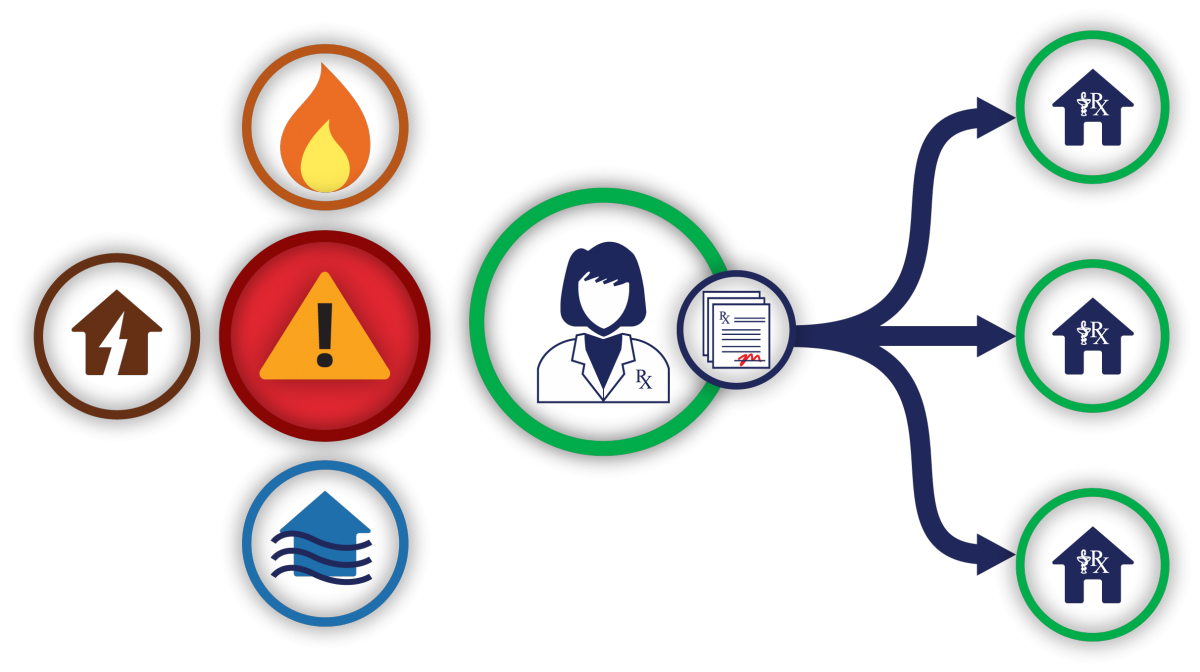Accessing Medications You May Need During a State of Emergency
Earthquakes, floods, tsunamis and wildfires are just some of the potential hazards in BC.
Medical records may be difficult to access during a disaster. If you rely on a prescription, talk to your primary health care provider or pharmacist about how to keep an extra supply or valid prescription in your emergency kit and grab and go bags.
If you have been displaced by an evacuation, you can also visit a pharmacy near you to access an emergency supply of medications you may need. The College’s Find a Pharmacy tool can help you locate a pharmacy in the community where you are staying.
To learn more about how to prepare for an emergency, visit gov.bc.ca/PreparedBC.
Emergency Health Provider RegistryThe Emergency Health Provider Registry (EHPR) is an online registry to support the proactive deployment of health care providers to ensure BC’s health care system is best prepared to respond to emergencies (e.g., wildfires, floods, pandemics). It is an online registry of health care professionals and health authority staff who are able and willing to be deployed or hired to support BC’s health system response. For more information or to register visit the Health Provider Registry for BC’s Emergency Response (gov.bc.ca) website. |
Providing Continuity of Care for Patients during a State of Emergency
Professional Practice Policy 31 – Emergency Supply for Continuity of Care outlines what’s expected of pharmacists in providing emergency supplies of medication for continuity of care for patients during a state of emergency.
Pharmacists are required to use their professional judgement, thoroughly document any medications they provide and communicate with the patient’s prescriber as soon as possible.
PharmaNet also plays an important role in supporting continuity in care by allowing a pharmacist to review a patient’s prescriptions and medication history regardless of what pharmacy a patient typically uses.
Learn how to make PharmaCare claims for patients affected by an emergency
See information for from PharmaCare on Patient Care During States of Emergency and Evacuations.
Participating in Local Emergency Management Plans
In BC, local governments lead the initial response to emergencies and disasters in their communities.
Pharmacy managers should reach out to the Emergency Program Coordinator for their community to ensure they are aware of and participate in local plans.
Learn more about Local Authority Emergency Management Programs in BC.
Unanticipated Pharmacy Closures
The need for an unanticipated pharmacy closure may arise in unforeseeable situations where, for instance, a state of emergency has been declared, or evacuations orders have been issued, and the pharmacy becomes temporarily inaccessible to the public.
Professional Practice Policy – 46: Temporary Pharmacy Closures (PPP-46), as well as Section 18(2)(dd) of the PODSA Bylaws, outlines what’s expected of pharmacy managers in the event that they are faced with an unanticipated closure of their pharmacy.
|
Professional Practice Policy-31: Emergency Supply for Continuity of Care This policy provides guidance to pharmacists when providing patients with an emergency supply of prescription drugs for continuity of care in exceptional circumstances in accordance with the Pharmacy Operations and Drug Scheduling Act (“PODSA”) Bylaws section 19(7)(d). POLICY STATEMENTS: A pharmacist may exercise professional judgment to provide a patient with an emergency supply of prescription drugs for continuity of care using the following principles:
|
Questions
For questions related to providing continuity of care for patients during a state of emergency, contact the College’s practice support at [email protected].
Pharmacists and patients can also contact the First Nations Health Authority at 1-800-317-7878 to verify patient identification information and for NIHB billing purposes.
Resources
Emergency Info BC
Emergency Info BC is the Provinces hub for disaster information. Visit their website and follow them on Twitter for the latest active provincial emergency information.
Flooding
- Information for Residents and Evacuees Affected by Flooding (Emergency Info BC)
- Interactive Map of Flooding Evacuation Orders and Alerts (Emergency Info BC)
- Flood Warnings and Advisories (River Forecast Centre)
- Cleaning Up After the Flood (Emergency Info BC)
Wildfire
- Information for Residents and Evacuees Affect by Wildfire (Emergency Info BC)
- Interactive Map of Wildfire Evacuation Alerts, Orders and Active Wildfires
- Wildfires of Note Across BC
- Provincial Wildfire Service
- Wildfire smoke and air quality
- Health and safety around fire retardants/suppressants
Earthquakes and Tsunami
- Earthquake and Tsunami Guide (Prepared BC)
- Earthquakes Canada
- Tsunami Notification Zones for British Columbia
Avalanche
Weather
First Nations and Aboriginal People
- First Nations Health Authority – Health Emergency Management
- Indigenous Service Canada – Emergency Management
Emergency Preparedness
- PreparedBC (www.gov.bc.ca/PreparedBC) Prepare Your Home
- Apartment and Condo Preparedness
- In It Together: Neighbourhood Preparedness
- Preparedness for People with Disabilities
- Local Authority Emergency Management Programs
Roads
 Share
Share



